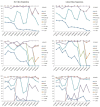An Evaluation of Fit Indices Used in Model Selection of Dichotomous Mixture IRT Models
- PMID: 38756464
- PMCID: PMC11095322
- DOI: 10.1177/00131644231180529
An Evaluation of Fit Indices Used in Model Selection of Dichotomous Mixture IRT Models
Abstract
A Monte Carlo simulation study was conducted to compare fit indices used for detecting the correct latent class in three dichotomous mixture item response theory (IRT) models. Ten indices were considered: Akaike's information criterion (AIC), the corrected AIC (AICc), Bayesian information criterion (BIC), consistent AIC (CAIC), Draper's information criterion (DIC), sample size adjusted BIC (SABIC), relative entropy, the integrated classification likelihood criterion (ICL-BIC), the adjusted Lo-Mendell-Rubin (LMR), and Vuong-Lo-Mendell-Rubin (VLMR). The accuracy of the fit indices was assessed for correct detection of the number of latent classes for different simulation conditions including sample size (2,500 and 5,000), test length (15, 30, and 45), mixture proportions (equal and unequal), number of latent classes (2, 3, and 4), and latent class separation (no-separation and small separation). Simulation study results indicated that as the number of examinees or number of items increased, correct identification rates also increased for most of the indices. Correct identification rates by the different fit indices, however, decreased as the number of estimated latent classes or parameters (i.e., model complexity) increased. Results were good for BIC, CAIC, DIC, SABIC, ICL-BIC, LMR, and VLMR, and the relative entropy index tended to select correct models most of the time. Consistent with previous studies, AIC and AICc showed poor performance. Most of these indices had limited utility for three-class and four-class mixture 3PL model conditions.
Keywords: fit indices; maximum likelihood estimation; mixture IRT models; model selection.
© The Author(s) 2023.
Conflict of interest statement
The authors declared no potential conflicts of interest with respect to the research, authorship, and/or publication of this article.
Figures
Similar articles
-
The Impact of Test and Sample Characteristics on Model Selection and Classification Accuracy in the Multilevel Mixture IRT Model.Front Psychol. 2020 Feb 14;11:197. doi: 10.3389/fpsyg.2020.00197. eCollection 2020. Front Psychol. 2020. PMID: 32116973 Free PMC article.
-
Comparison of Relative Fit Indices for Diagnostic Model Selection.Appl Psychol Meas. 2017 Sep;41(6):422-438. doi: 10.1177/0146621617695521. Epub 2017 Mar 8. Appl Psychol Meas. 2017. PMID: 29881100 Free PMC article.
-
Model Selection for Multilevel Mixture Rasch Models.Appl Psychol Meas. 2019 Jun;43(4):272-289. doi: 10.1177/0146621618779990. Epub 2018 Jun 7. Appl Psychol Meas. 2019. PMID: 31156280 Free PMC article.
-
Model selection and psychological theory: a discussion of the differences between the Akaike information criterion (AIC) and the Bayesian information criterion (BIC).Psychol Methods. 2012 Jun;17(2):228-43. doi: 10.1037/a0027127. Epub 2012 Feb 6. Psychol Methods. 2012. PMID: 22309957 Free PMC article. Review.
-
Sensitivity and specificity of information criteria.Brief Bioinform. 2020 Mar 23;21(2):553-565. doi: 10.1093/bib/bbz016. Brief Bioinform. 2020. PMID: 30895308 Free PMC article. Review.
Cited by
-
On the Use of Elbow Plot Method for Class Enumeration in Factor Mixture Models.Appl Psychol Meas. 2025 May 20:01466216251344288. doi: 10.1177/01466216251344288. Online ahead of print. Appl Psychol Meas. 2025. PMID: 40406583 Free PMC article.
References
-
- Akaike H. (1974). A new look at the statistical model identification. IEEE Transactions on Automatic Control, 19, 716–723.
-
- Alexeev N., Templin J., Cohen A. S. (2011). Spurious latent classes in the mixture Rasch model. Journal of Educational Measurement, 48(3), 313–332.
-
- Al Hakmani R. (2018). Bayesian estimation of mixture IRT models using NUTS [Unpublished doctoral dissertation]. Southern Illinois University at Carbondale.
-
- Al Hakmani R., Sheng Y. (2023). Empirical evaluation of fully Bayesian information criteria for mixture IRT models using NUTS. Behaviormetrika, 50, 93–120.
-
- Aryadoust V. (2015). Fitting a mixture Rasch model to English as a foreign language listening tests: The role of cognitive and background variables in explaining latent differential item functioning. International Journal of Testing, 15(3), 216–238.
LinkOut - more resources
Full Text Sources



